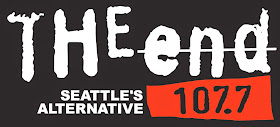On Memorial Day 1982, Seattle woke up to a pretty AWESOME new radio station.
At
Midnight, May 30, 1982, KZOK-AM, a '70s pop station called "Solid Gold 16" dropped it's tired
format and became KJET 1600. They signed on the air for the very first
time with "I Love Rock N' Roll" Joan Jett & The Blackhearts.
And yes, this was on the AM radio band. The one your wingnut, Thanksgiving-wrecking uncle gets off on these days.
Actually,
the correct frequency of KJET was 1590 kHz on the AM band and not 1600, but this was
back in the days when digital tuning radios were brand new, very rare
and VERY expensive. So most radio stations at that time identified with
the next closest number on the analog dial - preferably one that was
actually visible on an analog tuning radio dial, such as 1600 in KJET's
case. For example, a station on 106.9 MHz would call it's frequency "FM
107" or a station on 92.5, just "92", "92 FM", etc
KJET
specialized in a format that was defined as "New Wave" then, the
precursor to Alternative. On that day (which I remember well, I was
listening and became HOOKED on this station) you heard The Police, Missing Persons, The
Go-Gos, The Clash, Thompson Twins, Joan Jett, Soft Cell, Roxy Music,
Devo, Joe Jackson, Human League, The Motels, Jules & The Polar Bears
and many other acts of the time on KJET in 1982.
They added
more different and increasingly diverse acts to their format over time
and plenty of local rock and even some of the earliest Seattle grunge.
KJET also introduced Seattle to R.E.M., Kate Bush, Bauhaus, Camper Van
Beethoven, 54-40, The Cocteau Twins, Lloyd Cole, Depeche Mode, Erasure,
Nina Hagen, Robyn Hitchcock, Siouxsie & The Banshees and countless other alternative rock acts.
KJET also aired nightly live concerts, album features, hard to find imports and local independent rock programming. KJET was also a frequent sponsor of many live concerts.
Airplay on KJET was just
as important as L.A's KROQ and KITS in San Fransisco for many
alternative bands.
Yet sadly, KJET was treated like the bratty stepchild of FM Classic Rocker KZOK and
KZOK's then-owners really never liked it from the beginning. But there was
really nothing else they could do with it. No other broadcaster wanted
to buy the station then because of 1590's spotty daytime signal and they
knew it would cost more money to flip it in the long run than stay the
course.
KJET, for all it's warts and underachieving ratings (the
typical KJET listener wasn't in the demographic ballpark of Arbitron
anyway) did have quite a number of dedicated listeners and it was very
influential (members of Soundgarden. Mudhoney and Pearl Jam were
listeners.)
It's nighttime signal also could be picked up in Eastern
Washington and as far north as Alaska, where there were no local
alternative rock stations in those areas until the '90s, KJET was there
in the '80s, if only via a ghosty, uneven skywave and only after dark.
In those areas, KJET was a virtual lifeline for fans of alternative
rock. One guy in Spokane once told me how he couldn't wait for night to
come so he could listen to his favourite music on KJET. In the
pre-internet era, you took what you could get.
Surprisingly,
KJET was also
automated much of the time and DJs recorded their voice
tracks on one tape and the music on another. Sometimes the
automation would get out of synch and you heard jocks back announcing
songs that didn't come up until later in the playlist!
Yes, it was AM, yes it was scrappy. But it was
ours.
KJET
wasn't Seattle's first alternative rock station. That distinction
belongs to KZAM-AM 1540 (yes, AM again) out of Bellevue, which was "The
Rock Of The '80s...Broadcasting In Modern Mono" and they lasted from
1979 to 1981 when it flipped to Smooth Jazz as KJZZ.
But KJET was the
only source of alternative rock for most of the '80s in spite of very
worthy FM competition from
KYYX-FM 96.5 from 1982 until 1984.
KJET outlived them. But not for long.
(Bob Powers epitomized the attitude and look of radio station managers in the late 1980s.)
KJET lasted
6 years and was suddenly dropped in preparation for a sale of KZOK/KJET in September 1988 in favor of a
'50s-'60s oldies format called KQUL or "Kool Oldies" in the hopes of
gaining bigger ratings and more AM friendly older listeners. It's last song was "We're Through Being Cool" Devo.
The oldies format was a disaster and in spite of the outcry of
thousands of Seattle rock fans, KJET was officially dead and KJET's
corporate owners were not bringing it back.
It was three cold
years before a new alternative rock station called
The End 107.7 signed on in 1991.
AM
1590 was later Seattle's affiliate of the hair metal
Z-Rock radio
network (as KZOK-AM again) in early 1990 after realizing almost NOBODY
was listening to the oldies format and returned to breaking in many
local (but grunge rock/thrash metal) acts in the daytime hours and
regained some small ratings (1.6), though nowhere near as much as KJET
had at it's peak (3.7).
At night and on weekends they returned
to the Z-Rock network until October 1993 when Z-Rock dropped all their
AM affiliates to go FM only and KZOK decided to sell their AM station.
It simulcasted it's Classic Rock FM sister station
KZOK-FM for a year until it was finally sold to a corporate religious broadcaster in
1994, where 1590 AM languishes today as
KLFE, another amplitude modulating mouthpiece of the lunatic fringe (or the station your wingnut, Thanksgiving-wrecking uncle is listening to these days.)
Today, the KJET call letters reside at an FM pop station in Aberdeen, WA that has no connection with the original Seattle AM station.
But KJET still has a huge fanbase on the web, who have
created tribute sites to this little imperfect, but EXTREMELY
influential AM radio station.
Here are a few links to KJET's tribute sites:
KJET 1600 Black Box (Online tribute station with original KJET promos and sweepers)
KJET's Facebook Page
Crosscut article on KJET
10 Things 'Zine: KJET
KJET on Twitter


















































